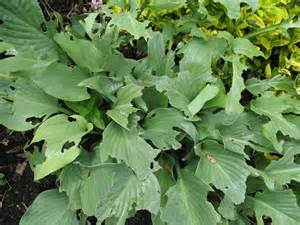Slugs and snails can be a significant pest problem on many varieties of landscape and vegetable plants in Florida. As they mostly feed at night, they can be difficult to detect, but the damage that they leave behind should be evidence enough. While some other insects, such as caterpillars and grasshoppers, leave similar damage patterns, those critters can usually been seen during the day making the pest diagnosis easier.
So, how can you be sure that the damage to your plants is being caused by slugs and snails? You can set a trap for them! Slugs and snails like to spend their daylight hours in a cool, dank place, so you can make that easier for them by creating a place for them to go to! Position a large flat rock or similar type of object at the base of the plants that are being fed upon, and then check under it daily, in the cool of the morning. You will see them resting under the rock, thereby confirming that you have a slug or snail problem. As well, you can sometimes see their slime trails on concrete or leaf surfaces, which is also clear evidence.
So, once you have identified that you have a slug and snail problem, you will need to find a way to get rid of them. Slugs and snails can be difficult to eradicate, but with determination and persistence, you can control them. One way, or course, is to apply a commercial slug and snail bait product available at garden centers, but it can be costly and may have to be applied often, depending upon the weather. Another way to eliminate the problem is to change out your landscape and garden plants to a variety that is less favorable to them, as they do have their favorite host plants such as Hosta and Peace Lily.
Fortunately, there are some other options to control slugs and snails, that are not only organic, but also fun and clever. Any of these following methods will work, but you may want to incorporate all of them in your pest control program:
- Remember the flat rock that we used earlier to help identify the presence of slugs and snails? Add a few more of those to the garden and then check under them daily, preferably in the morning. Physically remove the snails, bag them up, and throw them away!
- Beer. That's right, slugs and snails love beer! Dig a shallow hole in the ground near the plants that are being fed upon, and place an empty plastic butter tub or similar in the hole, so that the container is flush with the surrounding soil. Fill the tub half way with beer, and then wait. Slugs and snails love beer, and will fall into the tub at night and drown. Empty the tub every few days as needed, and fill again. Continue repeating this program until the population is eventually reduced, when you aren't trapping any more pests.
- Add copper banding to the base of you plants. Slugs and snails hate copper, as it is believed that it gives them an electrical charge. This method is more practical as a physical barrier at the base of a plant, or as a copper strip added to the lip of a potted plant, or similar concept. As well, you may have heard that you can use pennies, but that is not true today, as pennies no longer have copper added to them.
By now, you may have realized that controlling slugs and snails in your garden may not be easy, but with a plan and some persistence, your efforts will pay off. By using these organic pest control methods in a mufti-faceted program, you will eventually be able to enjoy your favorite plants, free of slug and snail damage!
So, let's get slug and snail hunting folks!
Donell

